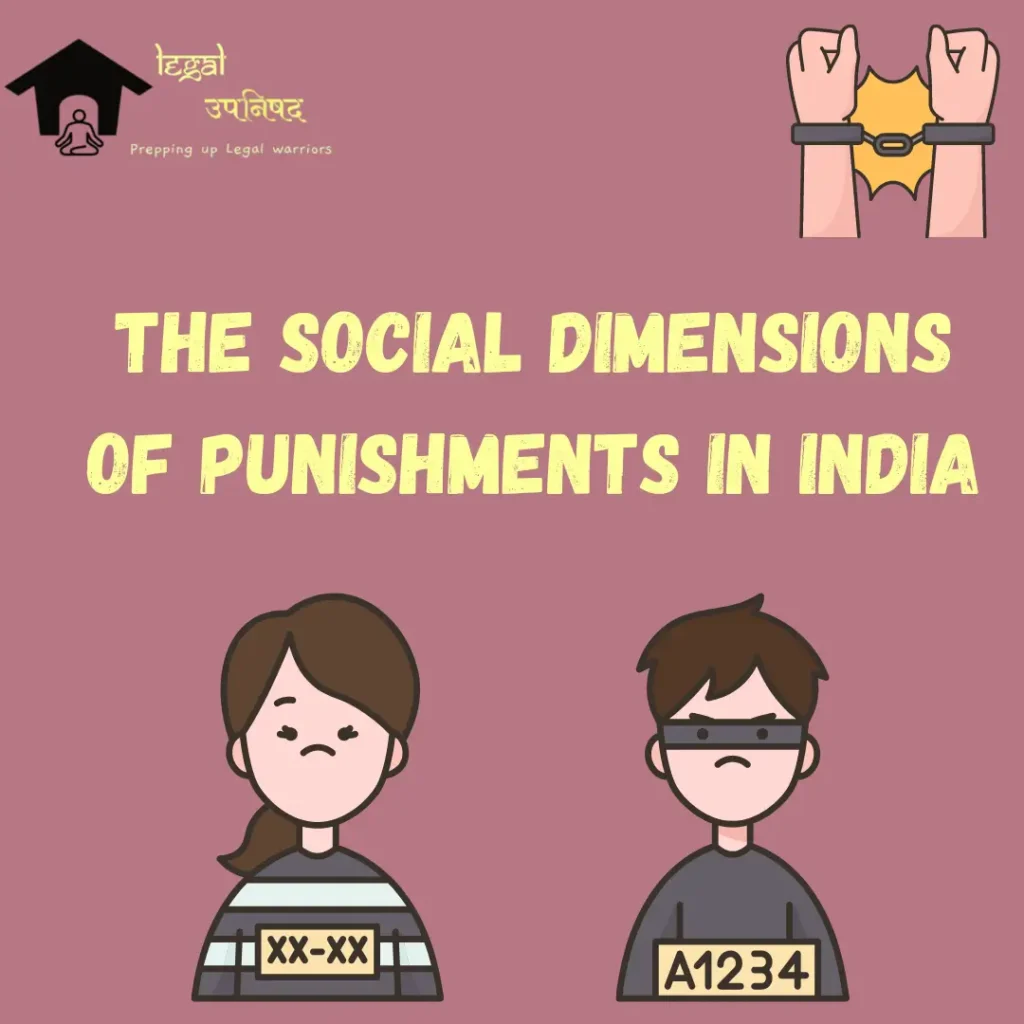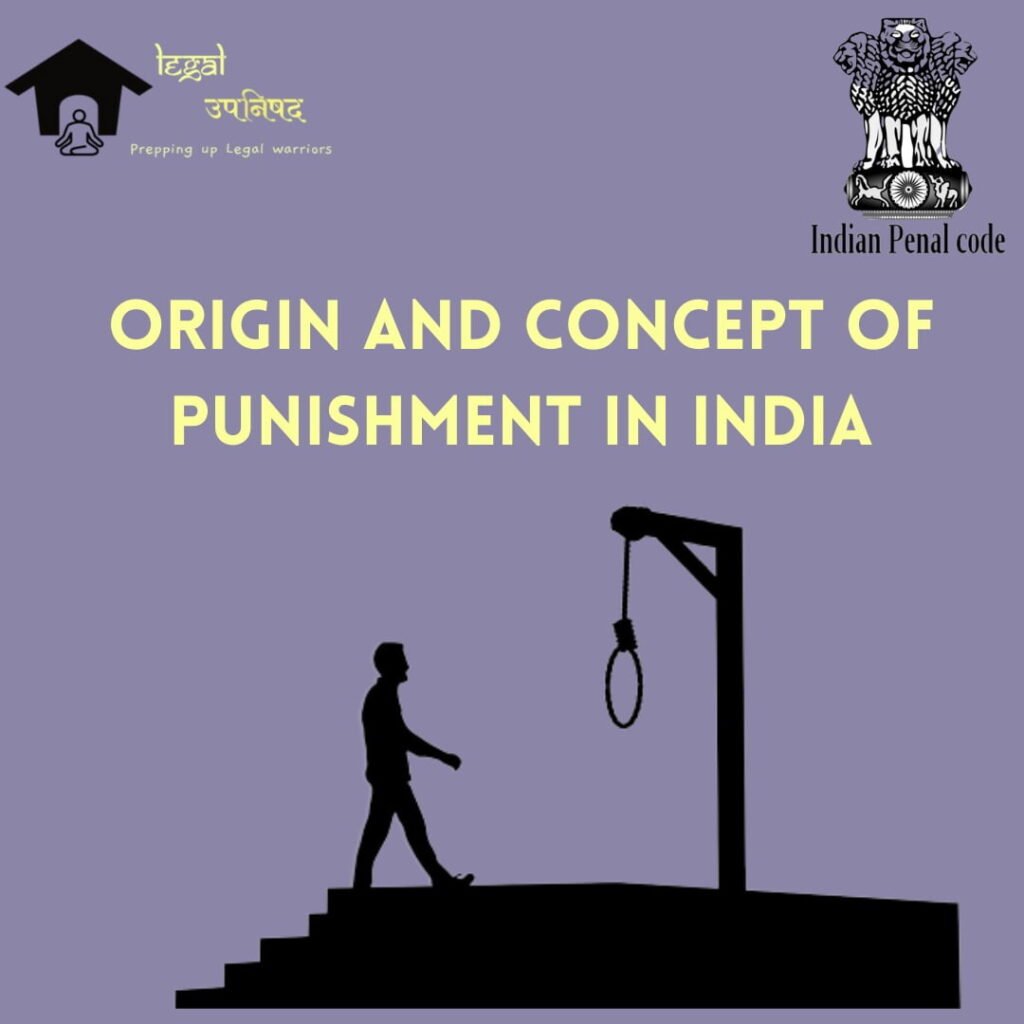This article on ‘Punishment in India: Evolution, Laws and Theories 2022’ was written by Shruti, an intern at Legal Upanishad.
Introduction
Laws in a country should change by the change in circumstances and situations. In the same way, the position of law on punishments has also evolved. There were different types of punishments followed in ancient India which got changed in certain ways and now the punishments given by India are on a different level. There are theories to support the concept of punishment but there are arguments that talk about not giving severe punishments and support human rights.
This article focuses on the position of law on different punishments in India and discusses social dimensions of the same along with a brief on the different theories of punishment.
The Social dimensions of Punishment in India
Punishment is a method to correct the fracture of societal harmony. The term fracture means the threat to the shared morals, norms, values and the identity of the group or the society. The state regulates society’s shared values and norms and punishes those who commit infractions. Punishment is not only a method for correcting the threats to societal harmony, it can reveal the relationship between how situations, administrative tactics and social mechanisms create the society, importantly it perpetuates inequality among people. The men who lived in the tribal society were governed by customary rules.
The Manu introduced criminal jurisprudence in India and ordinances related to law and order. It was a digest of the customs, religion and practices followed by people. Both social creations of the body in India and law are deeply embedded in the ritual systems and religious ideologies which lead to the ultimate legitimizing force for the social order that has been established.
Evolution of Punishment in India
Looking into the forms of punishment in ancient India were based on the retributive and deterrence theory. The punishments provided were brutal, twisting, and ruthless in nature as it was considered to be the only way of social control for the crimes committed in one’s kingdom. At that time, the crimes were comparably less. The punishments that were provided in ancient India are:
Capital Punishment:
It is a punishment that is legally authorised to kill someone for the crime he committed. At that time death penalty was given for even small crimes and it is an extreme form of punishment. The way of execution varied at different times.
Corporal Punishment:
This kind of punishment causes physical pain in a person and it is also known as physical punishment. This is given for the violation of law and the main objective here is to prevent the criminal from repeating the crime.
Social Punishment:
Here a person is not allowed to create any contract with other persons or to move to other places where he has no contract so that he could not get any help.
Financial Punishment:
Also known as an imposition of a fine. This is the common type of punishment and is assigned specially for the breach of revenue laws, minor crimes, etc. It also includes paying compensation to the victims and the costs of prosecution.
With the development of civilization, the process of punishment has also evolved. The punishments in modern India are less cruel and harsh and it gives importance to correction than to punish. As the forms of punishment evolved, the process of punishment and the process of pronouncing punishment has also evolved and became much more precise when compared to the ancient punishments. In modern India, the judiciary is responsible to maintain law and order. The court examines both the accused and the aggrieved in every aspect and then gives the judgement of acquittal or conviction.
Capital punishment is considered to be the most severe form of punishment, the two methods used in providing capital punishment in India are hanging and shooting. Human Rights started certain movements which opposed giving capital punishment in the process of judgement as it is considered to be a violation of an individual’s right to life. Both human rights and the death penalty under the Indian Criminal Jurisprudence are co-related, where it is based on the combination of two theories such as reformative and preventive theory. The President of India has the power to suspend his execution only after the court gives the sentence of the death penalty.
There are many crimes for which the death penalty is provided and there is also a category in which even if the offender has committed a heinous offence, there are chances for them not to receive capital punishment. So, under IPC the death penalty is given only in the rarest of the rarest cases. Various other punishments will be discussed below in detail.


The Types of Punishments in India
Section 53 of the Indian Penal Code, 1860 describes five kinds of punishments:
Death sentence:
As discussed above, the death penalty is capital punishment where the offender’s life is taken away by the authority as a punishment for an offence. This is imposed in extremely grave crimes and it can also be imposed on a person who does a pre-planned crime and premeditated murder in cold blood. Capital punishment is awarded as punishment for offences like waging war against the government, murder, dacoity accompanied with murder, kidnapping for ransom, etc.
Life imprisonment:
It means deprivation of liberty of the offender without his consent. Life imprisonment means the offender should be imprisoned for the whole of the remaining period of his life. The life convict will be released after the completion of fourteen years of imprisonment only on special occasions. The government may also consider the good behaviour of the convict. The IPC provides about fifty offences such as waging war, sedition, conspiracy, etc.
Imprisonment:
This means captivity that is, putting someone in prison. This punishment is mentioned under section 53 of IPC. Imprisonment is of two types one is simple and the other imprisonment is rigorous. The court has the power to decide the description of sentencing under section 60 of IPC. There are various types like wholly or partly rigorous, simple or any term to be rigorous and the rest to be simple.
Rigorous Imprisonment:
This means hard labour. Some offences are provided with rigorous imprisonment, for example, trespassing, fabricating false evidence, etc. for these offences rigorous imprisonment is imposed on the convict. The convict will be put in hard labour like cutting stones, digging the earth, etc. but they should be paid minimum wages.
Simple Imprisonment:
When there are lighter offences like the unlawful purchase of property by the public servant, not obeying the order of a public servant, obstructing the traffic, etc. then simple imprisonment is imposed.
Forfeiture of Property:
Losing property without compensation in return is forfeiture of property. This is the result of the default that was caused by the person in paying penalty for illegal conduct or in terms of contractual obligation. The forfeiture of property has been abolished under two provisions they are, under section 126, if commits depredation on territories of Power at peace with the Government of India and under section 127, receiving property taken during war and depredation mentioned under section 126 of IPC.
Fine:
It is also known as monetary punishment and it is derived from the word “Finis”. The sections that are related to providing punishment include fines punishment. The fine may be extended and the amount of fine to be given by the offender is unlimited, but it should not end up being excessive. This kind of imprisonment can be an alternative or an addition to imprisonment. Fine is mostly given in situations like false statements, illegal payments related to elections and failure in keeping election accounts.
Different theories of punishment:
Deterrent Theory:
This theory refrains anyone from doing a particular act that is, it restrains the offender from committing a crime. As the punishments given here are much more severe, fear is created not only in the criminal’s mind but also in other people’s minds so, the offender is considered an example for society and other people who have any criminal intentions. This theory is still available in certain Islamic countries. Some of the drawbacks are it didn’t create fear within the criminals after the punishment is over and within the mind of hardened criminals and creates sympathy among the public for criminals
Retributive theory:
This theory is also known as vengeance theory which means to pay back that is, to return the same thing that has been received. Tit or tat is the principle here which is basically against the principle of Mahatma Gandhi. The concept here is that if the offender receives the same torture which he gave to the victim then he will feel the pain for what he has done. This theory is one of the ancient theories of justice. Some of the drawbacks of this theory are that it intensely irritates the offender, and reflects the wild character of justice.
Preventive theory:
In order to prevent crime, it disables the offenders from repeating the crime by providing a punishment. Here, when the criminals were kept in jail, they were also kept out of society. This theory includes death, life imprisonment, etc as punishments.
One of the drawbacks here is, that it fails to give another chance to the juvenile offenders and others who are committing the crime for the first time.
Reformative theory:
This theory reforms the criminals and makes them into law-abiding citizens. This theory is based on Gandhi’s principle, hate the sin, not the sinner. It is believed in this theory that the offender might start a new life after receiving his punishment. The drawbacks here are, that the habitual offenders fail to meet the object of this theory.
Compensatory or expiatory theory:
This theory talks about self-realization. The offender must be forgiven if the offender realizes his offence. The drawback here is that this theory is too idealistic and impracticable in modern society.
Incapacitation theory:
Fear is created in the minds of offenders and future generations before committing a crime as the criminals are put into a state of being incapacitated to prevent the offence which means deprived of strength or power. Capital punishment and life imprisonment are examples of this theory.
Utilitarian theory:
This theory uses methods like crippling, disablement, etc. to prevent criminals from committing crimes. This theory consists of both negative and affirmative results and these punishments are harsh. The death penalty for committing murder is an example.
Multiple approach theory:
A combination of theories is the choice if a single theory fails to meet the objective. So, the court should take a judicial approach when selecting theories of punishment.
Conclusion
The purpose of giving punishment is to avoid and reduce crime in society. The heinous crimes like murder and rape for which the punishments are provided cannot fulfil the damage they caused so, fair and speedy justice should be provided to the victims. The principle that the innocent should not be punished, should be followed by the court while awarding punishment. The age-old colonial punishments are not suitable anymore and the punishments that are available now in India should be implemented for the wrongdoers in the right manner.
The social dimensions related to punishment and the punishments which were given in ancient India has been evolved as the law should evolve in accordance with the change in circumstances and there have been reforms in the criminal justice system of India.
References:
- Punishments in India 2022: All You Need to Know Retrieved: https://legalupanishad.com/punishments-in-india/
- Ashika Ranjan, Evolution of the process of punishment in India. Retrieved: https://www.ijlmh.com/paper/evolution-of-the-process-of-punishment-in-india/#:~:text=Process%20of%20punishment%20has%20evolved,used%20in%20the%20modern%20India.
- Kinds of punishment under IPC Retrieved: https://lawcorner.in/kinds-of-punishment-under-ipc-when-may-death-sentence-be-passed/#Kinds_of_punishment
- 8 kinds and theories of punishment Retrieved: https://www.writinglaw.com/5-theories-of-punishment/

